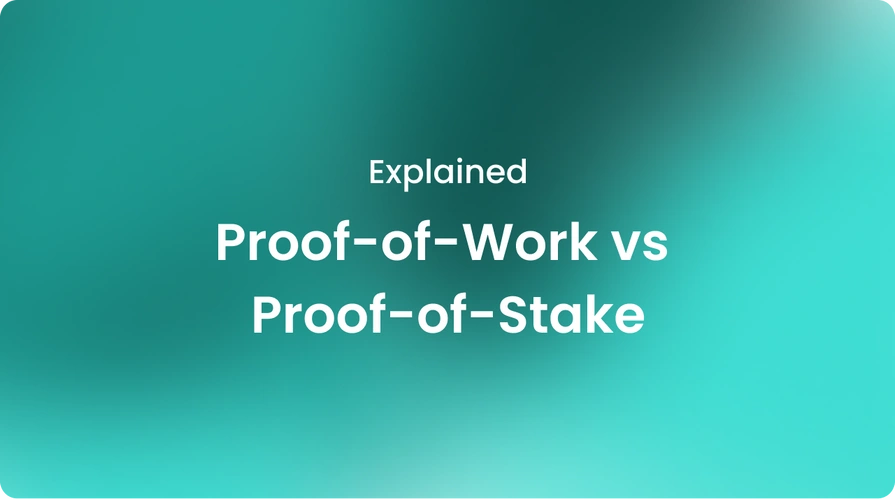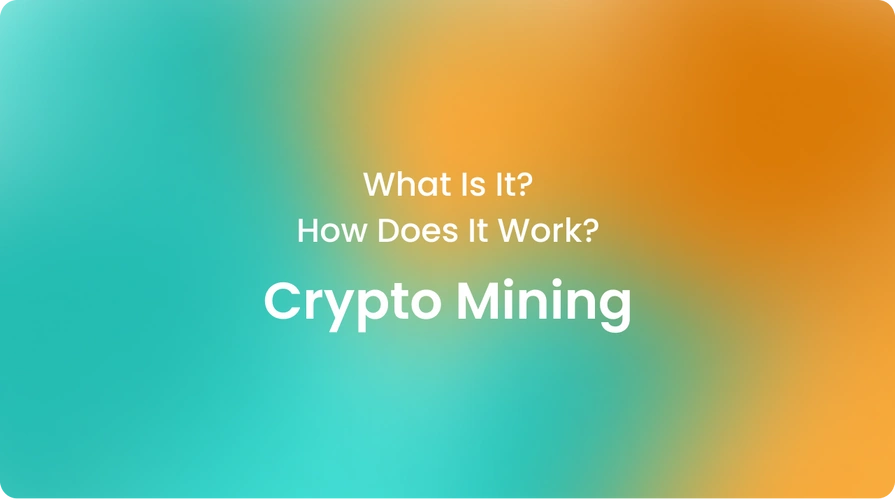|knowledgehub, technology, crypto
Proof-of-Work vs Proof-of-Stake: Explained

The blockchain's security for crypto transactions relies on consensus mechanisms such as proof-of-work and proof-of-stake. By using computer systems to check transactions, they help reduce the possibility of fraud.
One big difference between proof-of-work vs. proof-of-stake is how the blockchain algorithm chooses users and makes sure they are suitable for transactions. Join us in this blog as we explore each mechanism, their benefits, and how to use them.
In blockchain technology, stakers are rewarded for their participation with transaction fees and may receive extra tokens at block validation, as well as being penalized if their downtime or unproductive behavior degrades the integrity of the blockchain.
This system was implemented to prevent double spending on cryptocurrencies, which would devastate their value and undermine one of their main features: immutability and trustlessness.
Some implementations, like delegated proof-of-stake, select validators using hash power or stake size criteria, while others prefer a coin age selection method when selecting validators.
Compared to proof of work (PoW), PoS requires less energy expenditure while remaining eco-friendly. Before highlighting the other differences between proof of work vs. proof of stake, let’s get into the details of both consensus mechanisms.
What is proof-of-stake (PoS)?
Proof of stake (PoS) is a cryptocurrency consensus mechanism involving stakeholders staking crypto coins or crypto tokens as collateral to form new blocks, with more stakes increasing the chance that one of their transactions is selected to validate and produce rewards for the network.
As Cryptobunq, we provide you with what you need regarding PoW and PoS. Cryptobunq provides you with the software and guidance required, especially for PoS solutions for your businesses or financial projects as a crypto service provider.
What are the three benefits of a PoS?
POS software gives you the power to produce real-time reports of sales, purchases, customers, and more, helping to streamline operations and make your store more effective.
Proof-of-stake systems allow participants to secure their native cryptocurrency tokens and earn rewards if selected to verify transactions. A selection algorithm prioritizes those with more staked tokens while still keeping the odds balanced fairly evenly.
Proof-of-stake reduces the energy costs associated with proof-of-work consensus mechanisms while speeding up transaction times.
What is proof-of-work (PoW)?
Different types of cryptocurrencies frequently use proof-of-work in a blockchain network as a verification process for new transactions. It requires computer miners competing to write and validate the next block to demonstrate ownership of specific coins before any validation can occur.
Proof-of-work consensus mechanisms involve high-powered computers competing to solve intricate puzzles and cryptographic equations in the hopes of becoming the first miner to verify a block and earn cryptocurrency as a reward for their hard work.
But this crypto mining process has come under fire for its excessive energy use, particularly since it concentrates mining activity where electricity costs are lowest, potentially increasing the risk of 51% attacks.
What are the three benefits of a PoW?
PoW may be energy intensive, but it offers superior security and reliability compared to proof of stake. For instance, PoW can prevent blockchain forking by making it harder for an attacker to exploit 51% of total computing power unless they possess 51% themselves.
PoW can also assist a blockchain by verifying transactions and adding them to its chain, helping maintain its integrity by verifying which transactions belong to which blocks without consulting other types of blockchain nodes for confirmation.
Mining nodes provide this function so they can identify which transaction belongs in a particular block without needing to consult other nodes about identifying which transaction belongs there.
PoW can also serve as an objective force during times of crises in the crypto ecosystem, such as an abrupt split in Bitcoin's network where various versions are competing for legitimacy.
With the aid of PoW, reconciling chain histories and reestablishing canonical chains is relatively straightforward, making PoW an invaluable asset in this realm of cryptocurrency.
How is proof-of-stake different from proof-of-work?
Proof-of-stake differs from PoW by permitting users to participate via delegated staking pools managed by elected individuals or groups with relevant knowledge.
Furthermore, this system encourages honest behavior among validators and pool operators by penalizing dishonest acts with confiscated assets. These are significant features for proof of work vs. proof of stake.
Proof of work requires powerful computers to solve complex mathematical equations at great expense in both energy and money; those who complete first are rewarded with newly mined cryptocurrency or lower transaction fees.
Miners participating in proof-of-work blockchains must "stake" digital currency coins that belong to the network before using their computer processing power to validate a block, usually consisting of several transactions.
Verifiers for each new block are chosen randomly; those with larger stakes or experience have greater chances of being selected as verified verifiers.
Is proof of stake better than proof of work?
Both consensus mechanisms offer their own distinct advantages. Proof of work relies on fast computers and high energy usage to verify transactions; however, as blockchain size increases, transaction times increase as well.
Proof-of-stake can be more energy efficient as its validators are selected based on their stake in the network, but it could become centralized if too few large stakeholders control too much currency supply. Additionally, it is more vulnerable to 51% attacks if an attacker acquires enough coins from within it.
Proof of work and proof of stake both help verify transactions on crypto networks, but their differences lie in how the network selects which users can verify transactions and provides incentives to do so.
Why do companies use PoS?
Many companies have turned to PoS mechanisms. Critics have often accused proof of work of being wasteful of energy and encouraging centralization among mining pools, yet it remains the dominant model in crypto.
Popular coins are gradually switching to proof of stake, while newer blockchains use this method exclusively. Proof-of-stake gives users who possess significant amounts of the cryptocurrency token access to identify blocks and validate transactions on a network.
Miners, on the other hand, compete to solve complex mathematical equations using high-powered computers, competing to add their solutions to a blockchain ledger with updates of new blocks of transactions that they contribute in return for rewards in crypto tokens.
For example, Ethereum switched from proof of work to proof of stake in 2022 because PoS is both affordable and more secure than its predecessor. However, PoS remains in development, and becoming validators requires significantly more time and money compared with using PoW.
How do I use PoS?
Using the PoS is possible in a few simple steps, such as the following:
- Create a crypto wallet: You should keep your assets in your wallet and secure your crypto assets.
- Staking: Thanks to staking, the security of your assets is ensured.
- Validator: Validators are selected through algorithms among the ecosystem users who have made stakes. Validators verify transactions and create new blocks. Blockchain technologies reward these processes.
All these steps can be done via a reputable financial platform such as Cryptobunq. You can launch your PoS services and create a secure crypto wallet with custody and wallet solutions with Cryptobunq.
CBQ is a one-stop-shop crypto service provider for your crypto needs. You can benefit from our other crypto services, such as tokenization, exchange API, batch payments, node as a service, checkout and invoicing, and more.
As an expert and reputable crypto-friendly digital bank, you can trust CBQ. Contact us and take your business to the next level with our blockchain-powered solutions!













